Los Angeles is significantly hotter than its surrounding countryside. Concrete, asphalt, and buildings absorb and retain heat, raising nighttime temperatures by up to 22°F in some neighborhoods.
Annual heat waves in LA have nearly tripled since the 1980s. They also last longer — where a heat wave used to be a 2–3 day inconvenience, now it often spans 5 days or more, with more extreme high temperatures.
Nighttime lows have increased faster than daytime highs. Inadequate nighttime cooling stresses vulnerable populations and limits the body’s ability to recover. It also wreaks havoc on outdoor plants — unless they’re the hardy, heat-tolerant type.
What Makes a Plant Heat Tolerant?
Heat-tolerant plants have adapted to hot, dry climates and can flourish in the most brutal summer temperatures.
- Deep root systems help plants access water reserves deep in the soil.
- Waxy or hairy leaves reduce evaporation and prevent moisture loss.
- Small or needle-shaped leaves minimize surface area exposed to the sun.
- Drought tolerance allows plants to survive with minimal supplemental watering.
Plants native to arid regions or Mediterranean climates are naturally heat-tolerant and an excellent choice for Southern California gardens.
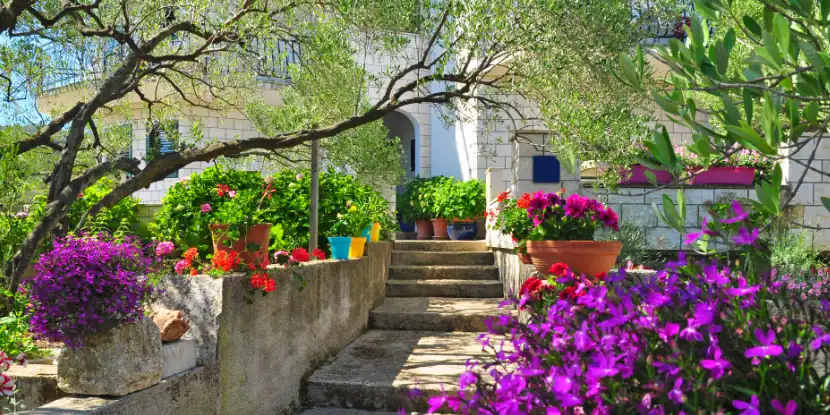
Heat-tolerant plants in a Mediterranean garden.
What Makes a Plant “Perennial?”
Unlike annuals, which complete their life cycle in one growing season, perennials grow and bloom over the spring and summer, die back in fall and winter, and return from their root system the following year.
Key Traits of Perennials
- They live for multiple years, often many.
- They regrow each year from the same root system.
- They bloom briefly each year, though some perennials bloom longer.
Common Ornamental Perennials
- Flowers: Daylilies, black-eyed Susans, coneflowers, hostas, peonies, lavender.
- Groundcovers: Creeping Jenny, vinca, ajuga.
- Shrubs and grasses can also be perennial, depending on the species and region.
Since many herbs originate from the sun-soaked Mediterranean, they tend to be heat-tolerant by default.
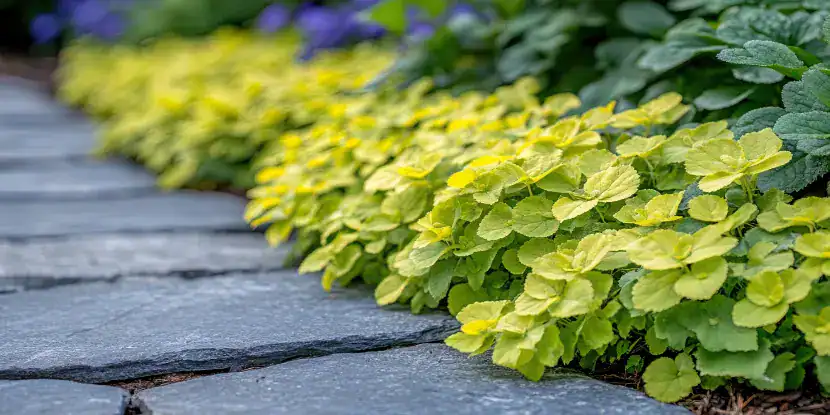
Creeping Jenny is a frequent border plant, though less heat-tolerant than other plants listed below.
Gardening Practices to Reduce Heat Stress
Even the most heat-tolerant plants need a little TLC during peak heat. Here’s how you can come to their aid:
- Mulch generously to retain soil moisture and keep roots cool.
- Water deeply and infrequently to encourage strong root systems.
- Position shade structures strategically for sensitive plants. Install pergolas or plant taller trees to provide natural shade.
- Group plants with similar watering needs to conserve water efficiently.
- Use drip irrigation systems to deliver water directly to the plant roots, minimizing waste.
- Amend soil with organic matter to improve its moisture retention and nutrient profile.
Now that you know what to do, we can decide what to plant.
Below, we’ve listed some of the best perennial flowers, groundcovers, herbs, and grasses for a garden in SoCal’s warmer areas.
Heat-Tolerant Perennial Flowers
1. Penstemon (Penstemon spp.)
- Bloom Time: Spring to early summer
- Height: 1–3 feet
- Colors: Red, pink, purple, blue
- Notes: Native, drought-tolerant, and attracts hummingbirds. Many varieties are used in xeriscaping.

Penstemon is native to California, drought-tolerant, and it attracts hummingbirds.
2. Yarrow (Achillea millefolium)
- Bloom Time: Late spring through summer
- Height: 1.5–3 feet
- Colors: Yellow, pink, white, red
- Notes: Tough, low-water, and great for cut flowers. A classic in waterwise gardens.
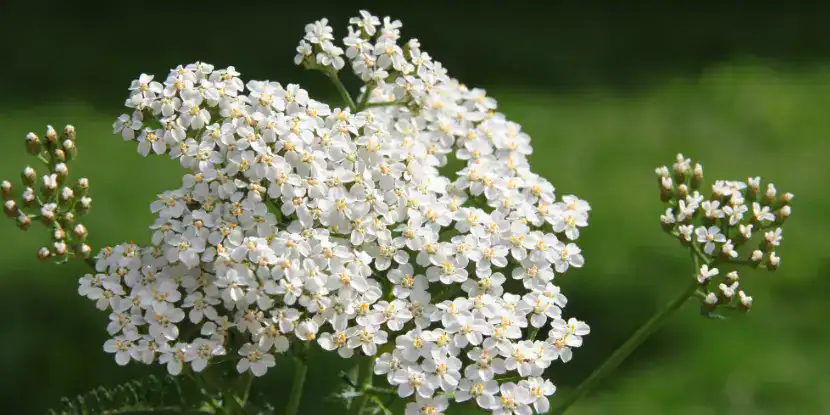
Yarrow is a tough, low-water plant with delicate blooms and foliage that can enhance a cut flower arrangement.
3. Salvia (Salvia nemorosa, Salvia greggii)
- Bloom Time: Spring through fall
- Height: 1.5–3 feet
- Colors: Purple, blue, pink, red
- Notes: Long bloom season, deer-resistant, pollinator-friendly. Many varieties are native to hot climates like Mexico and the Southwest USA.
4. Coneflower (Echinacea purpurea)
- Bloom Time: Summer to fall
- Height: 2–4 feet
- Colors: Purple, pink, white, orange
- Notes: Excellent for pollinators, long bloom period. Thrives in full sun and high temperatures once established.

Coneflower is excellent for pollinators and has a long bloom period.
5. Coreopsis (Coreopsis grandiflora)
- Bloom Time: Spring through summer
- Height: 1–2.5 feet
- Colors: Yellow, gold, red
- Notes: Reliable bloomer with low water needs. Often used in dry garden beds.

Coreopsis is a hardy plant often used in dry garden beds.
6. Black-Eyed Susan (Rudbeckia fulgida)
- Bloom Time: Summer through fall
- Height: 1.5–3 feet
- Colors: Golden yellow with dark centers
- Notes: Hardy, easy-care, and attractive to butterflies. A staple in sunny, low-water borders.

Black-eyed Susan is a frequent flyer in sunny, low-water borders.
7. Gaura (Gaura lindheimeri, now Oenothera lindheimeri)
- Bloom Time: Late spring through fall
- Colors: White, pink
- Height: 2–3 feet
- Notes: Airy appearance, long blooming, and exceptionally tolerant of heat and wind.

Gaura is long blooming and exceptionally tolerant of heat and wind.
8. Daylily (Hemerocallis spp.)
- Bloom Time: Late spring to summer (some re-bloomers)
- Height: 1.5–3 feet
- Colors: Wide range: yellow, orange, red, purple
- Notes: Easy to grow, drought-tolerant once established with occasional deep watering.

Daylilies are hardy and drought-tolerant once established.
9. Blanket Flower (Gaillardia × grandiflora)
- Bloom Time: Late spring through fall
- Height: 1–2 feet
- Colors: Red, orange, yellow (often bicolored)
- Notes: Thrives in hot, dry areas; long bloom period; attracts pollinators.
10. Jupiter’s Beard (Centranthus ruber)
- Bloom Time: Spring to fall (nearly year-round in mild climates)
- Height: 2–3 feet
- Colors: Crimson, pink, white
- Notes: Very heat- and drought-tolerant; thrives in poor soil; great for dry slopes or borders.

Jupiter’s beard flourishes in poor soil and is an excellent choice for great for dry slopes or borders.
Heat-Tolerant Ground Cover Plants
1. Lantana (Lantana camara)
- Size: 12–18 inches tall, spreads widely.
- Flower Colors: Yellow, orange, red, pink, white, multicolor
- Notes: Often grown as a shrub or groundcover; evergreen in frost-free zones. Superior plant for slopes and borders.
2. Dymondia (Dymondia margaretae)
- Size: 1–2 inches tall, spreads slowly to 1–2 feet wide
- Flower Colors: Yellow
- Notes: Dense, silvery-green foliage; excellent between pavers or in hot, sunny areas. Tolerates drought and foot traffic.
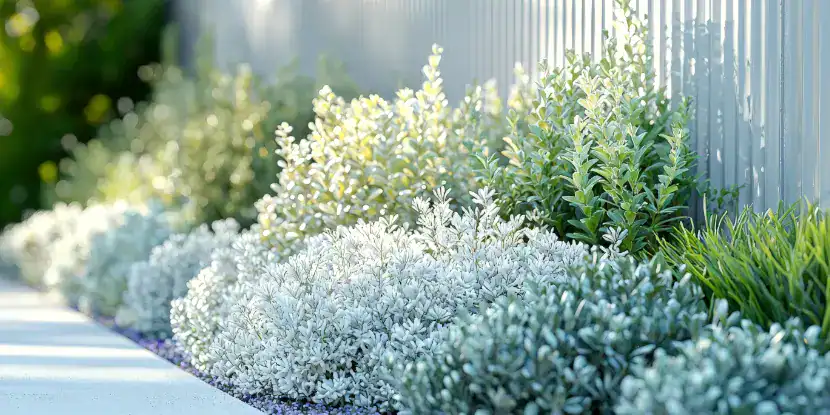
Dymondia tolerates drought and foot traffic, and its silvery-green foliage creates an elegant contrast in the garden.
3. Creeping Rosemary (Rosmarinus officinalis ‘Prostratus’)
- Size: 6–12 inches tall, spreads 4–8 feet wide
- Flower Colors: Pale blue to violet-blue
- Notes: Aromatic, trailing evergreen; ideal for slopes and erosion control. Highly drought-tolerant once established.
4. Trailing Gazania (Gazania rigens)
- Size: 6–10 inches tall, spreads 1–2 feet or more
- Flower Colors: Yellow, orange, white, red, pink, striped
- Notes: Fast-growing, sun-loving groundcover with showy daisy-like flowers. Great for dry, sandy soils.

Trailing gazania is fast-growing, sun-loving groundcover that does well in dry, sandy soils.
5. Creeping Thyme (Thymus serpyllum, T. praecox)
- Size: 2–4 inches tall, spreads 12–18 inches
- Flower Colors: Pink, purple, lavender, white
- Notes: Fragrant, edible leaves; tolerates heat and light foot traffic. Blooms attract pollinators.
6. Beach Strawberry (Fragaria chiloensis)
Size: 4–8 inches tall, spreads 12–24 inches
Flower Colors: White
Notes: Native to coastal California; attractive foliage and edible berries. Excellent for sandy or dry soils.

Beach strawberry are native to coastal California. They’re an excellent groundcover sandy or dry soils.
7. Creeping Jenny (Lysimachia nummularia)
- Size: 2–4 inches tall, spreads quickly
- Flower Colors: Yellow
- Notes: Vivid green or golden foliage; thrives in sun to part shade. Needs moderate water in hot inland zones.
8. Blue Star Creeper (Isotoma fluviatilis)
- Size: 2–3 inches tall, spreads rapidly
- Flower Colors: Pale blue to lavender-blue
- Notes: Delicate, star-shaped blooms. Great filler between stepping stones; prefers some moisture but handles heat with good care.

Blue star creeper prefers some moisture but handles heat well.
9. Sedum (Sedum spurium, Sedum rupestre, etc.)
- Size: 2–6 inches tall, spreads 12–24 inches
- Flower Colors: Pink, red, yellow, white (varies by species)
- Notes: Succulent leaves store water; thrives in hot, dry spots. Ideal for rock gardens, borders, and green roofs. Minimal water once established.
10. Woolly Thyme (Thymus pseudolanuginosus)
- Size: 1–3 inches tall, spreads 12–18 inches
- Flower Colors: Light pink to lavender
- Notes: Dense, fuzzy foliage with a soft texture. Handles sun, heat, and light foot traffic; often used between stepping stones or in dry landscapes.

Woolly thyme is often used between stepping stones or in dry landscapes.
Heat-Tolerant Shrubs & Ornamental Grasses
1. Red Creeping Fescue (Festuca rubra)
- Size: 6–12 inches tall, spreads widely via rhizomes
- Flower Colors: Reddish-tinted seed heads (not showy)
- Notes: Ornamental grass; used for meadows and erosion control, not for bloom display.
2. California Lilac (Low-Growing Varieties) (Ceanothus spp.)
- Size: 1–10 feet tall, depending on species or cultivar
- Flower Colors: Blue, lavender, white
- Notes: Technically a shrub, but low-growing varieties (like Ceanothus’ Yankee Point’) are used as groundcovers.
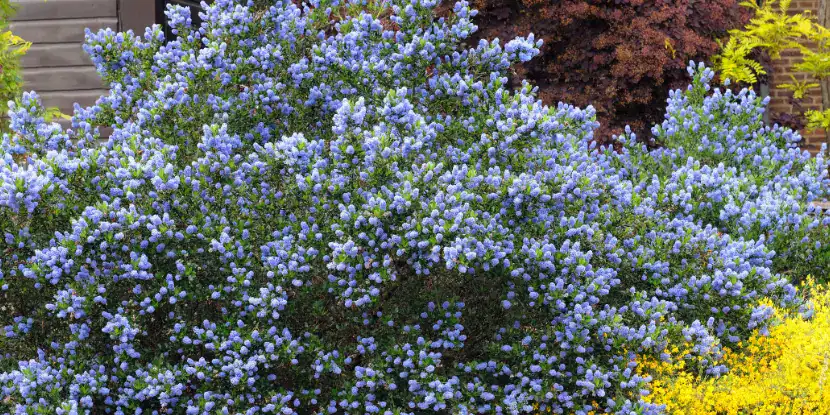
Lilac is a sweet-scented shrub that’s sometimes grown as ground cover.
3. Dwarf Coyote Brush (Baccharis pilularis var. pilularis’ Pigeon Point’)
- Size: 1–3 feet tall, spreads 6–8 feet
- Flower Colors: Creamy white (small and not showy)
- Notes: Grown primarily for dense green foliage and erosion control. Very tough native groundcover; attracts pollinators.
4. California Fuchsia (Epilobium canum)
- Size: 1–2 feet tall, spreads up to 4 feet
- Flower Colors: Bright red to orange-red
- Notes: Drought-tolerant once established. Excellent summer-to-fall bloomer for hot, dry slopes; hummingbird favorite.

A close-up of a bright orange fuchsia flower.
5. Purple Sage (Salvia leucophylla)
- Size: 3–5 feet tall, 6–8 feet wide
- Flower Colors: Light purple to lavender
- Notes: Aromatic foliage is highly drought-tolerant and typically used as a large shrubby perennial.
6. Deer Grass (Muhlenbergia rigens)
- Size: 2–4 feet tall and wide; flower spikes up to 5 feet
- Flower Colors: Tan, purplish, or silvery flower spikes
- Notes: California native bunchgrass; excellent architectural plant. Heat and fire-resistant.
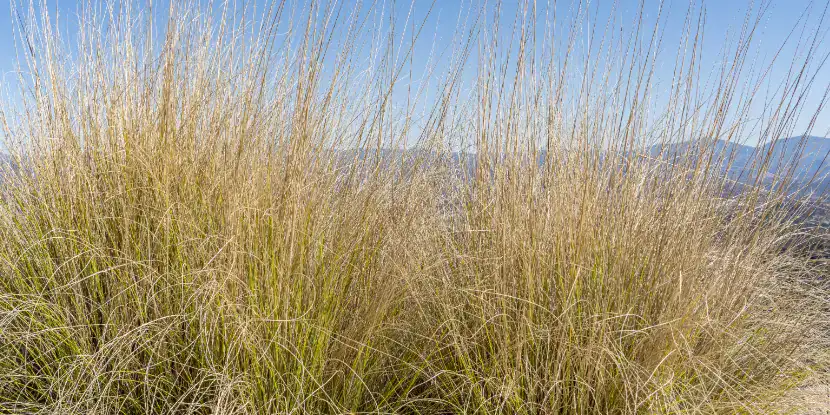
If deer grass in the desert, it can also grow in your heat-tolerant garden.
7. Toyon (Heteromeles arbutifolia)
- Size: 6–15 feet tall and wide (large shrub or small tree)
- Flower Colors: Creamy white
- Notes: Produces bright red berries in fall and winter; important for wildlife.
8. Woolly Blue Curls (Trichostema lanatum)
- Size: 3–5 feet tall and wide
- Flower Colors: Intense violet-blue with fuzzy texture
- Notes: Striking native with aromatic foliage; sensitive to overwatering. Attracts bees and hummingbirds.
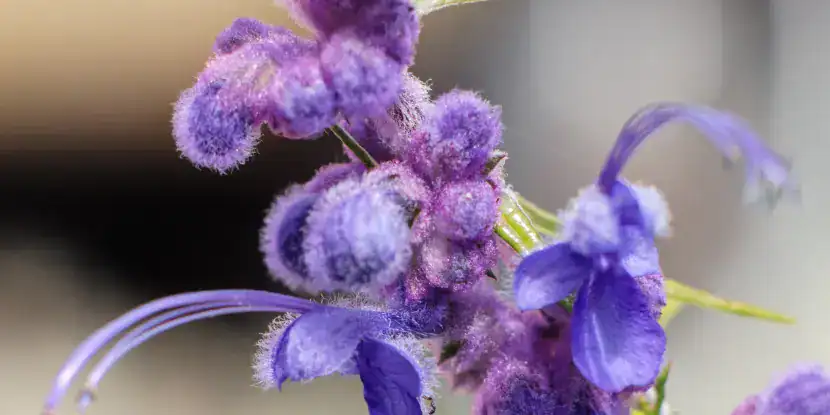
It’s not hard to imagine how woolly blue curls got its name.
9. Lemonade Berry (Rhus integrifolia)
- Size: 4–10 feet tall and wide
- Flower Colors: Pale pink to white
- Notes: Drought-tolerant evergreen shrub; excellent for habitat and slope stabilization. Dense, evergreen foliage provides excellent fire resistance and privacy.
10. Blue Oat Grass (Helictotrichon sempervirens)
- Size: 2–3 feet tall and wide
- Flower Colors: Pale tan or silvery seed heads
- Notes: Cool-toned ornamental grass with blue-gray foliage; adds fine texture and contrast.

A clump of blue oat grass in a park.
10 Heat-Resistant Landscaping Ideas
Take your garden design to the next level with these heat-savvy landscaping approaches.
1. Rock & Succulent Gardens
Rocks don’t burn, and succulents are legendarily hardy. Combine heat-tolerant succulents like aloe and agave with decorative stones for a low-maintenance oasis.
2. Mediterranean-Style Yards
No passport needed! Use olive trees, lavender, and rosemary to create a Mediterranean ambiance.

Mediterranean gardens are popular in California, especially for Spanish-style architecture.
3. Water-Wise Layers
Layer drought-resistant plants of varying heights for depth and visual appeal.
4. Minimalist Zen Gardens
Incorporate sand, gravel, and heat-resilient bonsai trees or cacti for a serene, low-water landscape.

A well-manicured zen garden with islands of greenery.
5. Pollinator-Friendly Spaces
Grow plants like salvia and coneflowers to attract pollinators that sustain your garden’s ecosystem.
6. Pathways with Ground Covers
Plant low-water ground covers like creeping thyme along pathways for beauty and practicality.
7. Fruit Trees
Install low-water trees like pomegranate or fig for a bonus of delicious fruit.
8. Terracotta Planters
Arrange heat-tolerant flowering plants in terracotta pots for a rustic look.

You can place a heat-tolerant terracotta garden almost anywhere, including a porch or balcony.
9. Wildflower Meadows
Plant drought-tolerant wildflowers to replace traditional lawns while adding vibrant color to your yard.
10. Outdoor Living Spaces
Design shaded patios with pergolas framed by climbing drought-resistant vines like bougainvillea.
Final Thoughts
Creating a thriving, low-maintenance garden in Southern California’s hot climate is easier than you think. By selecting heat-tolerant perennials and combining them with innovative gardening practices, your landscape can become a sustainable sanctuary.
Bookmark this guide or share it with fellow gardeners. Share your progress with us on Facebook or Instagram — we’d love your creative solutions!
FAQs: Heat-Tolerant Perennials
Q: What causes heat waves?
Heat waves occur when high pressure traps hot air, preventing it from moving or dissipating. This creates a dome of heat that can linger for days or weeks. Climate change is also contributing to more frequent and intense heat waves.
Q: Are there any annuals that tolerate extreme heat?
Several annuals, including sunflowers, zinnias, marigolds, and portulaca, can withstand high temperatures. These plants usually have shallow root systems and need regular watering to survive. However, they can add beautiful color accents to your garden during summer.
Q: What is the best time to plant heat-tolerant perennials?
Plant in early spring or fall when temperatures are moderate, giving plants time to establish before extreme heat.
Q: Can I grow heat-tolerant plants in containers?
Yes. Just ensure the pots have good drainage and adjust watering schedules accordingly.
Q: Do heat-tolerant plants require fertilizer?
Most don’t need heavy fertilizing. Use organic, slow-release fertilizers sparingly.
Q: How can I make my lawn more drought-tolerant?
You can replace traditional grass with heat-tolerant turf varieties like Bermuda or Zoysia grass, or substitute ground covers like Gazania.
Q: What’s the best water-saving irrigation method?
Drip irrigation is ideal as it delivers water directly to plant roots, minimizing evaporation.
Q: Are there native Californian plants that are heat-tolerant?
California Poppy, Matilija Poppy, and Ceanothus are excellent native heat-tolerant choices.
Q: How do I prevent weeds in my heat-tolerant garden?
Use a thick layer of mulch and consider ground covers to suppress weed growth naturally.
Q: What other features can I include to beat the heat in my yard?
Add shade features like pergolas, shade sails, mesh shade tarps, and water-efficient cooling fountains.

